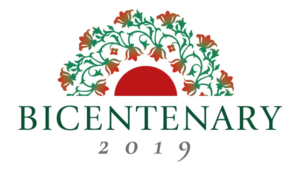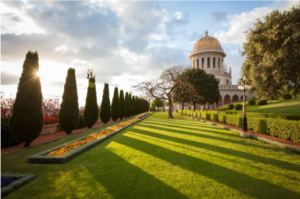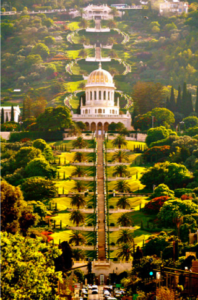Consideration of how important people such as great spiritual teachers can be deified by their followers.
For 10-14 year olds. Originally written by Dick Powell, updated in April 2019.
Learning Outcomes
Emerging
- Explain two key beliefs about Jesus and Gautama Buddha
- Explain what beliefs about Jesus and Gautama can be seen in an image of each
Expected
- Offer a view as to how far the ‘original’ message of Jesus and Gautama can be updated for future ages
- Offer a view as to how far humans tend to make their own meaning when it comes to religious teachings
Exceeding
- Give an example of an allegory or myth and explain the purpose of this type of thinking
- Give an example of a historical account and explain the purpose of this type of thinking
Key words and concepts
General
Deity: an alternative word used to describe (a) God or a goddess, or the Supreme Being.
Deification: the word to describe the process by which godlike or extra-ordinary powers are placed on humans to show their supernatural status.
Christianity
God: the word given to the Supreme Being in the Christian tradition. Usually meaning a personal, creator Being who interacts with his creation in various ways, and is considered the first attribute of the Trinity – i.e. God the Father.
Incarnation: The concept that God is able to take human form, and in Christianity the incarnation is in Jesus of Nazareth.
Christ: a Greek word meaning Messiah, or chosen one (of God).
Messiah: a Hebrew word literally meaning the anointed human (by oil) of God. Became a figure in later Jewish theology of a person who would liberate the Jews from oppression – like King David.
Son of God: a Christian term relating to a title given to Jesus demonstrating Jesus’ relationship with God.
Miracle: a supernatural event usually performed outside the laws of natural occurrences.
Trinity: The belief that God is Three-in-One or the Trinity. The core of the Nicene Creed states the acceptance of God as Creator and Father, belief in Jesus as the Son of God, and faith in the Holy Spirit that permeates and reinforces the work of the Church.
Buddhism
Buddhism: Buddhism can be divided into 3 main groups: Theravada, Eastern Buddhism and Northern Buddhism. While these groups share certain core beliefs, there are some differences in interpretation. The main difference with the Mahayana (a kind of Buddhism adopted in Eastern and Northern Buddhism) is the belief that Nirvana / Nibbana is not the ultimate goal of Buddhism. Instead everyone should aim to become a Bodhisattva and eventually a Buddha and help with the salvation of all beings. Theravadins, on the other hand, believe that, while the Bodhisattva path is the best possible goal, it is not for everyone, only the noble few. The majority of people should aim for Nibbana / Nirvana.
Re-birth: Existence is a cycle of birth and death through samsara going on indefinitely until a person can be liberated (Nibbana / Nirvana). Rebirth is like flame passed from one candle to another – not an immutable soul passed from body to body as in Hinduism.
Bodhisattva: for Mahayana Buddhists a bodhisattva a being who is destined for Enlightenment or Buddhahood but who postpones final attainment of this in order to help all living beings to attain it.
Theravada: literally meaning the Way of the Elders, this is generally considered the principal tradition of Buddhism. It was established in Sri Lanka and South East Asia and is now found in Thailand, Vietnam, Cambodia and Burma as well as Sri Lanka.
Mahayana: Mahayana Buddhism is a later development of Theravadin teachings and generally speaking is to be found in countries to the north of India in Asia such as Tibet, China, South Korea and Japan. Mahayana Buddhists see Buddhas and many Bodhisattvas as transcendent and beings to whom devotions and worship can be offered.
Sakyamuni: Siddhartha Gautama also known as Shakyamuni / Sakyamuni (sage of the Shakyas).
Upaya: skill-in-means – the ability to adapt a message to needs of the audience: a skillful way of teaching a great truth. See the parable of the Burning House in Buddhism.
Some of these terms are also key concepts. Here is some further background to some of these to help you prepare for the teaching and learning activities:
Trinity: The central beliefs of Christianity are summed up in the Nicene Creed which is recited each Sunday by Christians of most denominations in their act of worship, usually the Eucharist or Lord’s Supper. The Nicene Creed was drawn up in 325CE by the Council of Nicaea in order to defend the orthodox faith from various heresies that had arisen. This Creed is the belief that God is Three-in-One or the Trinity. The core of the Nicene Creed states the acceptance of God as Creator and Father, belief in Jesus as the Son of God, and faith in the Holy Spirit that permeates and reinforces the work of the Church. God the Father, God the Son, and God the Holy Spirit (2 Corinthians 13:14).
Messiah: a core concept in Christian and Jewish thought with a rich and ancient history stretching back to the time of King David. In Hebrew, originally meaning ‘the anointed’ one (as King David was with holy oil) it came to refer in New Testament times to a human character with king-like qualities who would free the Jewish people from all oppressors. It is likely that Jesus refused to accept this title, even though the word Christ is the Greek form of Messiah, preferring the title prophet. However, the title stuck and the early followers of Jesus probably called ‘Nazarenes’ by outsiders came to be known as Christians – or followers of the Christ – the anointed one sent by God to save his people from the realm of evil.
Trikaya: this is a word describing the three dimensions or bodies of the Bodhisattva concept and is an excellent, if complex, example of the way in which deification occurs from the human Theravadin Buddha character through to a vast cosmic Mahayana pantheon. The three dimensions of the Bodhisattva being the human nature of Gotama, the supernatural entities through which the dharma is transmitted, and the cosmic dimension of the dharma.
Bodhisattva: Mahayana Buddhists see Buddhas and many Bodhisattvas as being transcendent. This leads to devotional activities and worship. In Pure Land Buddhism, for example, faith in the Buddha Amitabha (or Amida) is emphasised. Adherents believe that faith and devotion will mean Amitabha will help them be reborn in the Pure Land he created in which Enlightenment is guaranteed.
Learning activities
Explain that the students are going to explore the lives and characters of two great religious founders in an attempt to discover what they thought about themselves, what their followers thought about them, and what people think about them today.
The intention of these learning activities is for students to gain an appreciation of the idea that ordinary people impose their own interpretations on events, people and experiences and that over the course of time people develop ideas which might differ from the intention of the original author but which might become mainstream ideas.
The focus of this lesson is Jesus of Nazareth and Siddhartha Gautama. Explain that both figures probably existed historically but that questions will be asked of the students about how this can be established. Suggest that the activities here will show how followers within the belief traditions of both figures, Christianity and Buddhism, have interpreted over time, sometimes gradually, sometimes quickly, the life and teachings of Jesus of Nazareth and Siddhartha Gautama so that the outcome we have in the 21st century might be different from the original intention of that founder. Suggest to the students that the learning activities hope to show that we need to appreciate that religious ideas develop over time, and are influenced by communities and cultures, and other historical events.
Remind the students that although some people today think of Jesus of Nazareth as the Son of God, and Siddhartha Gautama as man who attained Enlightenment, and then escaped from being reborn through Nirvana. The learning activities might demonstrate that we need to be critical about what these words mean.
Show different images of Jesus and Gautama Buddha. Can students identify them? How are they able to do this? Discuss if Jesus and Gautama Buddha would have really looked like this.
Create a set of images of Jesus in different cultural forms, some with a message intended by the artist, some telling a story of Jesus; life. For example; show a black, Chinese and Indian Jesus; search ‘Church Ads.net’ for Christian messages cleverly communicated with advertising campaigns; stories form Jesus; life such as miracles or the events of Holy Week. In pairs, students try to identify the meaning of the image for Christians, a message the artist or creator is trying to portray, and whether it would have made sense to 1st Century Jews, Jesus’ followers and companions.
Remind students of the trials of Jesus and if necessary provide the students with the Bible reference to the trial of Jesus by Herod (Luke 23: 6-12) to read in pairs.
As an individual exercise, suggest that they write a short report as a journalist for a newspaper as if they were at the trial and if they had the chance to ask Jesus some questions about his motives and actions, how he felt about his treatment, and how he sees the outcome. Encourage students to share their reports.
Return to the images of Siddhartha Gautama. Ask if students are less familiar with the stories of Siddhartha Gautama than Jesus of Nazareth. If so, ask them if this will affect their judgements, ideas, understanding of Gautama better or worse than Jesus?
Find a similar set of images of Gautama Buddha, such as in different cultural forms (Thai, India, Chinese, etc); at different points in his life (as a prince, starving, as a teacher, reclining prior to attaining Nirvana); and ways the Buddha image is used today, such as an ornament, in a Buddhist shrine, in association with mindfulness as therapy etc. ask pairs to conduct a similar discussion as for Christianity: what is the meaning of the image for Buddhists, what message is the artist trying to communicate, would the message make sense to North Indian people 2.5 thousand years ago?
Remind students of the story of the Buddha –find a clip online or retell the story of his early life, the 4 sights, and his renunciation of his life as a prince. Working in groups of three or four, ask students to present up to five similarities and differences between Jesus and Siddhartha, stressing not only physical ways but also ways they tried to find meaning in life.
Introduce a Stilling exercise of the type below:
A stilling exercise
Teachers of RE are usually familiar with stilling exercises. Follow your own procedures or use all or some of the following. After the exercise the students will be required to write a question on a sticky note and share this with their partner.
Allow the students to find a comfortable and secure place to sit or lie..
Once settled, lead the students in a breathing exercise so that they can become more focussed – this one is often used – instruct the students in an even and quiet voice to place their hand on their heart and listen for a heartbeat, ask them to feel the rhythm, and to see if it is slowing down or even, rapid or calm. Ask them keep their attention on their heartbeat and breathe regularly and calmly; and once they feel their breathing is in tune with their feelings of calm, to place their hand beside their sides and to listen carefully to the exercise. Hold the silence…
In a calm but quiet voice, taking pauses when necessary ask the students to see a path in front of them leading from the classroom to a delightful place in nature… it could be wide…. Or narrow…. winding…. Or straight… following a stream, or a coastal path ….to a forest or in the mountains… wherever the student feels most comfortable.
As you walk down the path you come to a small tree which has lots of branches. This is called the Tree of Troubles, and as you come to it, you pause …. and take any trouble you might have off your shoulders and hang it on the tree before you move off again..
You come to a small gate, it is bright green and as you pass through the gate you notice how all the flowers and trees, bushes and grass have become incredibly colourful and bright. The sun is shining, warm and it is exactly how you want it to be…
You notice a small tree to one side and underneath sits a man meditating cross legged. He is still and calm. His eyes are focused on a point a few inches from his nose. His hands are cupped in front of him on his lap. His name is Siddhartha.
As you approach him he opens his eyes and smiles in welcome. He looks kind… contented… happy and you have so many questions you want to ask him. He says “ask one question about me, but remember that words are valuable and you need to make them count”….
You ask the question. You wait and listen carefully for his answer…
You bow and say thank you – and you turn away back to gate… you go through it…. smiling as you pass the tree of troubles as you know those problems aren’t quite so bad now, and back to the classroom… and when you’re ready…
You open your eyes.
Follow up to the stilling exercise
Ask students to write down their question on the sticky note but not to show it to anyone at this point. Encourage students who couldn’t think of a question to think of one now.
Ask students to share their experiences as precisely as they can with a partner, discussing such questions as: What was the path like? What was the gate like? What did the man look like? Did the image of the man you saw have any features you could recognise? How did he act? How did he respond to your question? What question did you ask – if you think you can share it? Did you think of an answer that you might be given? What answer might we expect from a Buddhist? What answer might be given by a non-Buddhist?
Now consider these extremely challenging questions:
- Does it sometimes happen that what we imagine becomes our reality?
- Do we possibly impose on our reality what we would like rather than what is there?
- How do we go about answering these questions?
- Where should we look to find the answers to life’s deepest questions?
- What impact might answers to life’s deepest questions have on individuals?
Explain that the next learning activity moves on to an examination of story and texts, in order to show that many religious stories are not meant to be factual, nor written as factual by the authors, but interpretations by humans of human experiences. So some idea of what constitutes a story might be useful and the means by which students understand the tools that define these stories is helpful so this can be applied to religious stories – because the problem is that the words look similar, but have very different meanings, are easily confused and often Students might require access to computers in order to investigate the stories with which they are unfamiliar.
Explain that there are different ways of understanding stories from religious traditions. Ask them to work in groups of four to agree definitions and examples of five main types of religious story – firstly discussing and writing on sticky notes their own definitions; then looking at and discussing the definitions provided below and placing on the sheets with the examples.
Types of Story:
- Allegory
- Historical Account
- Legend
- Myth
- Parable
Suggested Definitions:
Allegory: A story using examples from nature to explain a moral or spiritual truth.
Historical Account: Description of what is actually believed to have happened, based on eye-witness testimonies.
Legend: A story using supernatural language to explain something about the relationship between humans and God.
Myth: An old or ancient story with some basis in historical fact.
Parable: A short story told to illustrate a moral point.
Examples:
- David and Goliath
- The Creation story in Genesis 1
- Robin Hood
- Coyote trickster
- The Good Samaritan
- The birth stories of Jesus
- The enlightenment of Gautama
- John Bunyan’s Pilgrim’s Progress
- Aesop’s story of the Fox and the Grapes
- Aesop’s story of the Tortoise and the Hare
- Icarus and Daedalus
- Dickens’ Christmas Carol
- Krishna’s birth
- Jesus’ parable of The Sower
- The Buddhist story of Kisa Gotami and the Mustard seed
- Atlantis
- Animal Farm by George Orwell
- Plato’s story of the cave
- King Arthur and the Round Table
- William Tell
- One Thousand and One Nights
Explain to the students that both Buddhism and Christianity have their own sacred texts and these are not only over 1500 years old or older but have also developed, been edited and have many assumptions in them about the faith. Such texts contain a mix of different types of story. Provide students with background information about Christian and Buddhist texts with the quotations on the Crucifixion of Jesus and Buddha’s Parable of the Burning House.
Ask students to focus on the story of Jesus’ crucifixion, e.g., how crucifixion was a Roman form of execution, not Jewish; how a purple cloak is meant to symbolise the kingship of Jesus, as purple was a colour reserved for royalty; how the charges against Jesus suggested he was being executed for treason and maybe rebellion against the Romans; how Jesus’ death is confirmed by the words “breathed his last”; how a leading Roman soldier made a statement about Jesus.
Ask students to read the five quotations from the story of the crucifixion of Jesus aloud to a partner.
Ask students to discuss the following questions in pairs or small groups:
- consider how this story would fit into the whole Christian story.
- If Jesus is referred to as the Son of God, what do you think the centurion meant by this, as he has just seen Jesus stripped, beaten and nailed to a cross?
- What do you think the term ‘Son of God’ means?
- Do you think the term ‘Son of God’ means that Jesus has the same characteristics and qualities as God? If so how does this work?
- If this is an eye-witness account of the event, what would your thoughts be seeing someone spoken of in this way in his death?
- Is it possible that the death of Jesus is interpreted by his followers to fit what they think rather than what Jesus thought of himself?
Now ask students to focus on the Buddhist Parable of the Burning House, noting that the story comes form the Lotus Sutra, and that there is no evidence to suggest that the Buddha actually spoke this text. It probably reflects the development of Buddhist thought and the manner in which his teachings are intended to help people understand his teachings. For Mahayana Buddhists, the Buddha has become a cosmic figure. He is eternal and has appeared in many forms in history to guide and comfort humans. The noblest form of the Buddha is as a Bodhisattva, who devotes himself to attaining Nirvana or ‘awakening’ for all beings. The parable may be seen as an example of upaya, (skilful means), in this case: a story about how something that is not actually ‘true’ in a literal way, being used as a skilful way of helping people to understand a larger ‘truth’.
Ask students to read the Parable aloud, in pairs, one paragraph at a time.
Ask students to discuss the following questions in pairs or small groups:
- consider how this story would fit into the overall Buddhist story
- Why do you think the children did not heed their father’s warning about the fire?
- In what ways are people today like the children in the story?
- What might wake people up to the way people waste their lives today?
- Do you think it matters whether this story was told by the Buddha or not? Why / Why not?
As a summary activity, ask students to work in small groups on a poster or digital presentation that compares the Christian and Buddhist stories. They should use pictures and text and ensure that they have included:
- similarities in the way Christians and the Buddhists may think about Jesus and the Buddha;
- different beliefs people hold about Jesus and the Buddha;
- answers to big questions that Christians and Buddhists can understand when they reflect on (a) the crucifixion and (b) the parable of the burning house;
- some of their own questions about the meaning and purpose of life that are raised in the two stories, e.g., suffering of innocent individuals, the role of God in the world, the impact of the Buddha’s teaching on individuals and the world;
- suggested answers to those questions that might be given by (a) Christians and (b) Buddhists;
- their own reflections on questions of ‘truth’.



